Physical Address
304 North Cardinal St.
Dorchester Center, MA 02124
Physical Address
304 North Cardinal St.
Dorchester Center, MA 02124

You’re not alone. Many people experience tension and discomfort in their hips, which can lead to a cascade of issues, including poor posture, decreased mobility, and even lower back pain. The good news is that incorporating gentle yoga stretches into your routine can provide significant relief. By focusing on specific yoga poses for hip pain relief, you can enhance your hip flexibility and promote a sense of overall well-being.
In this beginner’s guide, we will explore effective hip pain yoga techniques that are designed to alleviate discomfort and improve your quality of movement. Whether you’re a seasoned yogi or new to the practice, these gentle stretches will help you reconnect with your body and find comfort in every step.
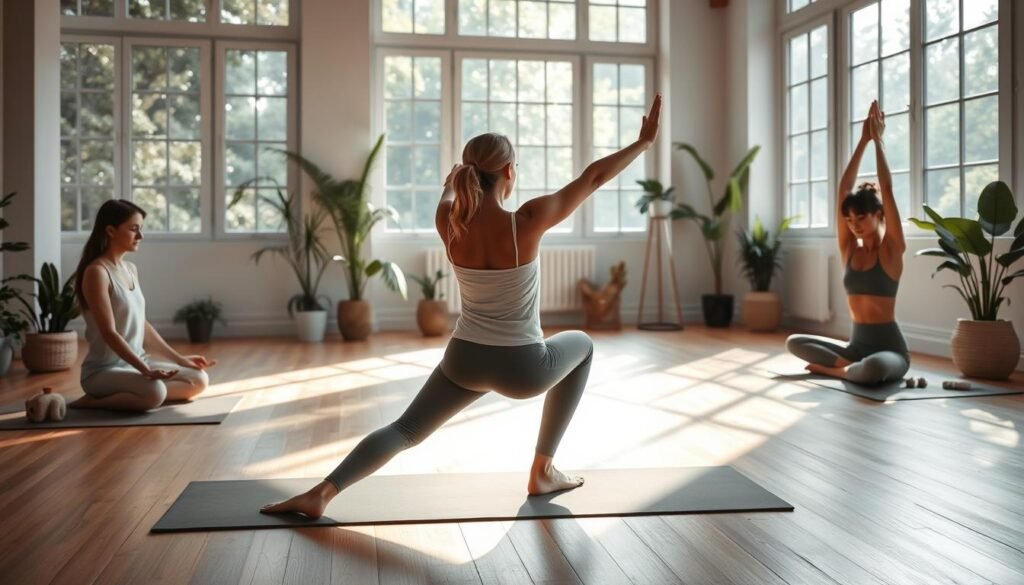
Consistency is key for keeping your hips flexible and mobile. Experts say to hold each stretch for 20 to 30 seconds and do them daily for best results13. Regular practice can help you move better, walk more easily, and feel less pain in your hips and lower back1.
Hip pain is common, especially for those who sit a lot or have poor posture. Knowing what causes hip pain is key to feeling better and avoiding more pain. Tight hip flexors and muscles, along with sitting too much and poor posture, are main culprits.
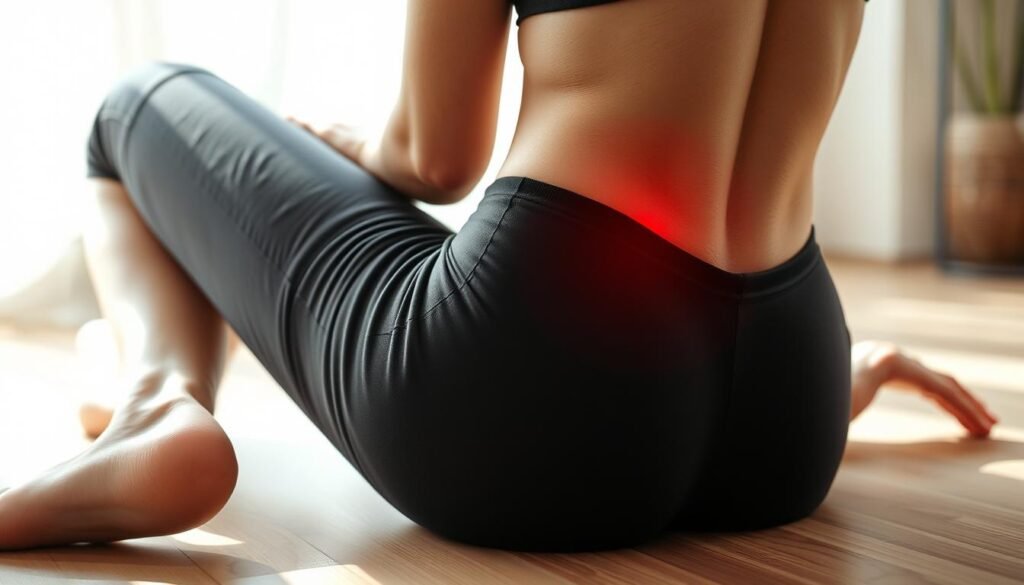
The hip flexors help us lift our knees and bend at the waist. When they get tight, it can hurt and stiffen the hip. This tightness often comes from sitting too long, not stretching enough, or doing too much physical activity.
Bursitis, labral tears, and hip impingement are common causes of hip pain. They can get worse with active lifestyles, getting older, being overweight, or injuries4.
Bad posture, like slouching or sitting for hours, can put lots of strain on the hip joints. Not moving much can also weaken the muscles around the hip. People with unusual bone shapes might be more likely to get labral tears4.
“Sitting for long periods can cause the hip flexors to become tight and shortened, leading to pain and discomfort in the hip area.”
| Cause | Description |
|---|---|
| Tight Hip Flexors | Muscles become tight due to prolonged sitting or lack of stretching |
| Poor Posture | Slouching or sitting for extended periods can lead to muscle imbalances |
| Sedentary Lifestyle | Minimal physical activity can weaken muscles that support the hip joint |
Core muscle injury, like sports hernias or athletic pubalgia, often happens in sports that involve a lot of twisting and turning without proper training4. Knowing these common causes can help us take steps to ease pain and prevent more problems. Doing too much in yoga, especially in advanced poses, or practicing with others instead of alone can hurt your hips5.
Yoga is a gentle way to manage hip pain. It uses targeted stretches and poses to help. Adding yoga to your daily routine can make you more flexible, reduce pain, and improve your overall health. A Cochrane Review protocol is looking into yoga’s benefits for hip or knee osteoarthritis, showing its potential for joint pain relief.
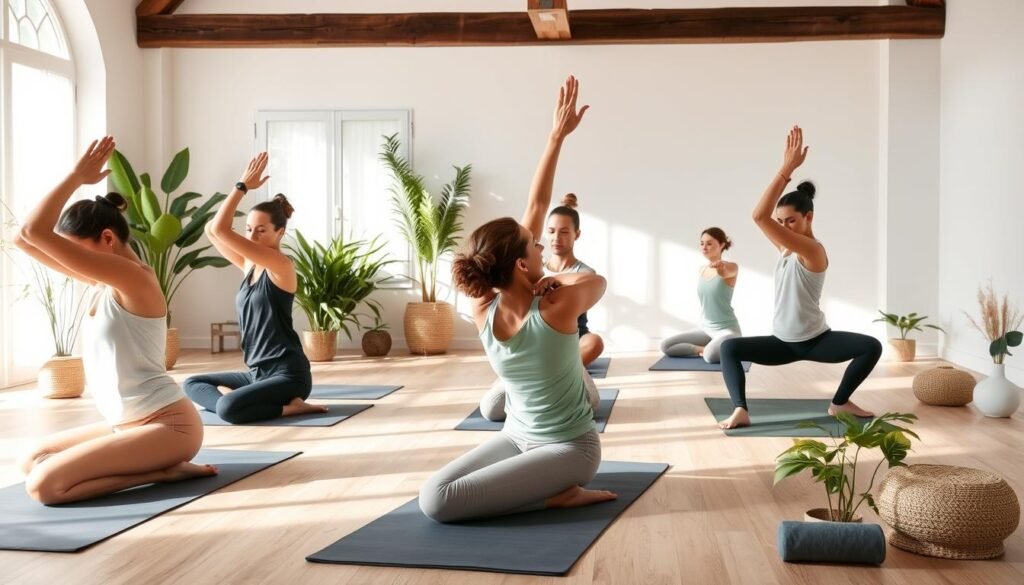
Yoga makes your hip joints more flexible, thus increasing hip mobility. This means you can move more easily and feel less stiff. As you get better and more consistent, you’ll find it easier to stretch deeper and hold poses longer.
Yoga’s stretches and poses work on the muscles around your hip, easing pain and stiffness. People who are active but not used to it often get hip pain from muscle imbalances6. Yoga can help with conditions like arthritis, fibromyalgia, and chronic fatigue syndrome7. It strengthens the muscles around your hip, reducing pain and improving health.
Poor posture and sitting too long can make your hip muscles tight6. Yoga teaches you to stand and sit correctly, helping your posture. It strengthens your core and improves alignment, easing hip strain and preventing future pain. Poses like cat pose, dolphin plank pose, and downward-facing dog are great for posture and alignment7.
Remember, yoga is safe when done right. But, injuries can happen if you push too hard or let a teacher push you too far8. If your hip pain is severe or doesn’t go away, talk to a doctor before starting yoga.
Before starting your yoga for hip pain relief, prepare your body and mind. Focus on your breath and set an intention to enhance your practice. Mindfulness in yoga means being present and aware of your body and thoughts.
Deep belly breathing relaxes you, reduces stress, and improves focus. It activates your calm state. Yoga breathing, like ujjayi breath, boosts your practice’s benefits.
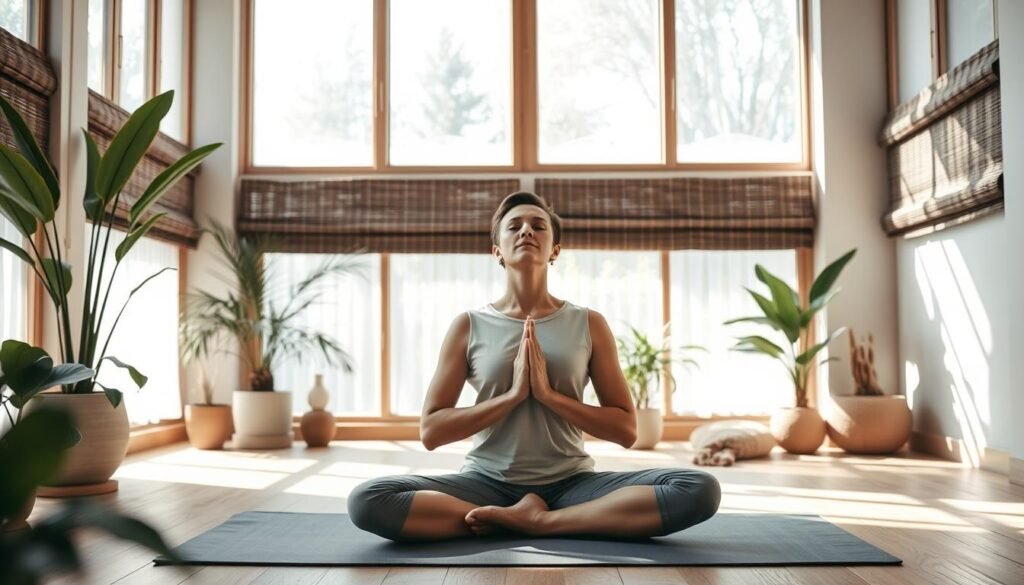
To do deep belly breathing, sit comfortably. Place hands on chest and belly. Inhale slowly, feeling your belly expand. Exhale slowly, feeling it contract. Repeat for several rounds, focusing on your breath.
Setting an intention keeps you focused and aligned. It could be a word, phrase, or feeling you want to cultivate. For example, ease, release, or self-compassion. An intention guides your practice and keeps you present.
To set an intention, sit quietly before practicing. Reflect on what you want to achieve. Repeat your intention or write it down. Bring your attention back to it when your mind wanders.
| Breathing Technique | Benefits |
|---|---|
| Deep Belly Breathing | Reduces stress, improves focus, and promotes relaxation12 |
| Ujjayi Breath | Calms the mind, increases concentration, and builds internal heat |
| Alternate Nostril Breathing | Balances the nervous system, reduces anxiety, and enhances mental clarity |
Even a quick two-minute yoga practice can boost endurance, mobility, and stability.13 Mindful breathing and intentions create a strong foundation for your practice. They benefit your body and mind.
Doing gentle hip opener yoga poses on the mat can help loosen tight muscles. It also makes your hips more flexible and can ease pain. These poses work on the muscles around the hip, like the hip flexors, glutes, and outer hips17.
Adding these stretches to your yoga routine can boost your hip’s mobility and stability. This is key to avoiding injuries and keeping your lower back and knees healthy17.
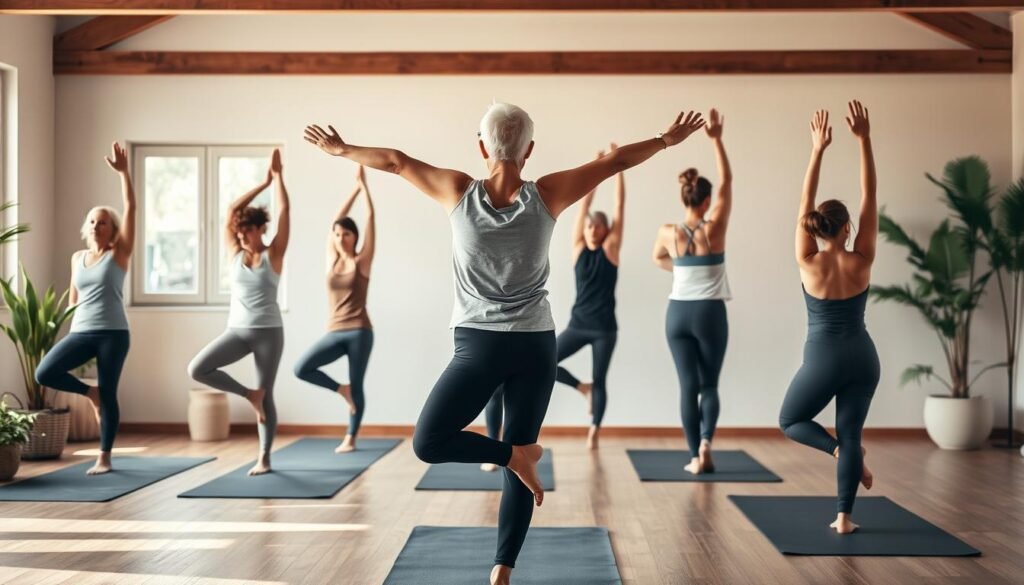
Remember, everyone’s hips are different, which can make some poses easier or harder18. Women might have unique hip structures due to childbirth18. But, with regular practice and the right alignment, anyone can enjoy these gentle stretches.
Fire Hydrants are great for working the outer hips and glutes. Here’s how to do it:
1. Start on your hands and knees, with your wrists under your shoulders and knees under your hips.
2. Lift your right leg out to the side, keeping your knee bent at a 90-degree angle.
3. Keep your core engaged and avoid arching your back.
4. Hold for 5-10 breaths, then lower your leg and repeat on the left side.
Seated twists are a gentle stretch for the hips and lower back. Here’s how to do it:
1. Sit on your mat with your legs extended in front of you.
2. Bend your right knee and cross your right foot over your left thigh.
3. Place your left hand on the floor behind you and your right hand on your right knee.
4. Gently twist your torso to the right, keeping your spine elongated.
5. Hold for 5-10 breaths, then release and repeat on the opposite side.
Reclined Figure Four is a restorative pose that stretches the hip flexors and glutes. Here’s how to do it:
1. Lie on your back with your knees bent and feet flat on the floor.
2. Cross your right ankle over your left thigh, creating a figure four shape.
3. Reach your right hand through the space between your legs and interlace your fingers behind your left thigh.
4. Gently pull your left thigh towards your chest, deepening the stretch in your right hip.
5. Hold for 5-10 breaths, then release and repeat on the opposite side.
It’s important to build strength and flexibility in the hips. This helps solve issues like tight or weak hip muscles18. By adding these gentle hip openers to your yoga, you can keep your hips healthy. This helps prevent problems like sciatica, sacroiliac joint pain, lower back pain, knee pain, and ankle issues18.
| Pose | Target Area | Benefits |
|---|---|---|
| Fire Hydrants | Outer hips and glutes | Strengthens and stretches the outer hips |
| Seated Twist | Hips and lower back | Improves spinal mobility and stretches the hips |
| Reclined Figure Four | Hip flexors and glutes | Releases tension in the hips and stretches the glutes |
Adding poses that target the core and hip flexors can help with hip pain. These poses strengthen these muscles, improve posture, and lower injury risk19.
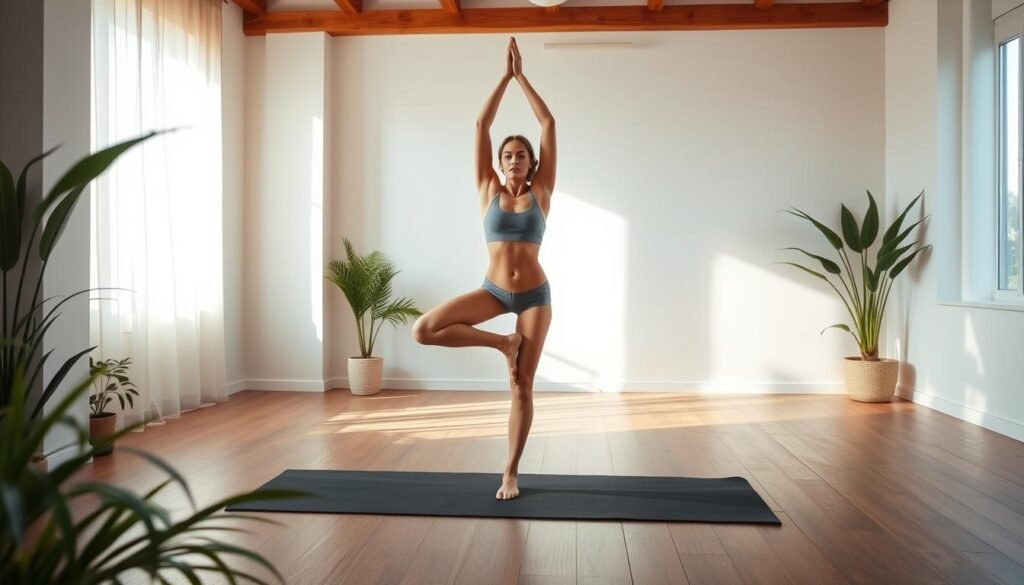
Boat Pose is great for the deep core and hip flexors. Here’s how to do it:
1. Sit on your mat with knees bent and feet flat.
2. Lift your feet, keeping shins parallel to the floor.
3. Extend your arms forward, keeping your spine straight.
4. Hold for 5 to 8 breaths, focusing on your core and balance20.
Bridge Pose stretches and strengthens the hip flexors, glutes, hamstrings, and core21. Here’s how to do it:
1. Lie on your back with knees bent and feet flat, hip-width apart.
2. Lift your hips, squeezing your glutes and engaging your core.
3. Hold for 5 to 8 breaths before lowering your hips back down20. It helps with tight hip flexors, common in a sedentary lifestyle, and can cause lower back pain and hip discomfort19.
| Pose | Target Areas | Benefits |
|---|---|---|
| Boat Pose | Core, Hip Flexors | Strengthens deep core muscles and hip flexors, improves balance |
| Bridge Pose | Glutes, Hamstrings, Hip Flexors, Core | Stretches hip flexors, strengthens glutes and core, relieves lower back pain |
Enter and exit these poses slowly and mindfully. Listen to your body and respect its limits20. If pain persists for more than two weeks, seek medical advice20.
To get the most out of yoga for hip pain, make sure to include these stretches daily. Even a few minutes each day can help reduce pain and improve movement22.
Try doing yoga in the morning or evening, or take short breaks to stretch your hips. Hold each stretch for at least 30 seconds23. Listen to your body and pick a stretch level that feels right for you23.
Yoga poses for opening the hips are great for beginners. They help improve flexibility and mobility24. These poses target key areas like the inner thighs and lower back23. Using props like blocks or towels can help adjust the poses to fit your flexibility level23.
It’s also important to strengthen the muscles around your hips, like the hamstrings and glutes24. A good yoga routine for hip arthritis or bursitis should mix stretching and strengthening exercises. This helps keep your hips healthy.
| Benefit | Description |
|---|---|
| Stretches hip muscles | Lengthens and loosens tight hip muscles |
| Reduces injury risk | Helps prevent hip-related injuries |
| Improves posture | Promotes better alignment and balance |
| Increases range of motion | Enhances flexibility and mobility in the hips |
Adding hip-opening stretches to your daily routine offers many benefits. You can stretch your hip muscles, lower injury risk, and improve your posture and balance22. Remember, taking care of your hips is key to your overall health and well-being22.
Adding gentle yoga stretches to your daily routine can help with hip pain. It also boosts flexibility and mobility. Knowing why hip pain happens, like tight muscles and sitting too much25, helps you take action. A 2021 study found sitting for long times can lead to hip pain26.
Getting ready for yoga is key, especially if you’re new to it. Learning to breathe right and setting goals helps you focus. A 2021 study showed that cells can feel and react to things26, showing yoga’s power to improve health.
Doing specific yoga poses and exercises can help with hip pain25. Studies show yoga and other exercises can help with stress and tight muscles26. Always listen to your body and enjoy the benefits yoga brings for your hips and overall health.
Hip pain often comes from tight hip flexors and muscles. This can happen when you sit for too long or don’t move much. Bad posture and a sedentary life can also make your hips stiff and less mobile.
Yoga is great for hip pain. It gently stretches your hips, making them more flexible and mobile. This can reduce pain and stiffness. Yoga also helps improve your posture and alignment, preventing future hip issues and boosting your overall health.
Some yoga gear can help your practice, especially for hip stretches. A yoga mat provides cushioning and grip. Yoga blocks can make poses easier. Straps and blankets offer extra comfort and support.
Preparing your body and mind for yoga is key. Start with deep belly breathing to relax and focus. Setting an intention for your practice and staying present can enhance yoga’s benefits for hip pain relief.
Standing poses are great for stretching and strengthening the hip area. Try Mountain Pose variations, like using a block or adding step downs and leg lifts. These target the hip flexors and muscles, helping with stability and pain reduction.
Gentle hip openers on the mat can release tension and increase flexibility. Fire Hydrants work the outer hips and glutes. Seated Twists stretch the hips and lower back. Reclined Figure Four deeply stretches the hip flexors and glutes.
Strengthening the core and hip flexors can help with hip pain. Boat Pose works the deep core and hip flexors. Bridge Pose strengthens the glutes and hamstrings, supporting the hip joints.
To fully benefit from yoga for hip pain, make it a daily habit. Even a few minutes of hip stretches each day can help. Try practicing yoga in the morning or evening, or take short breaks to stretch your hips.